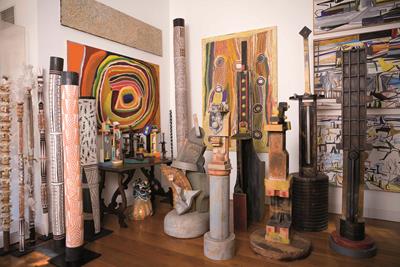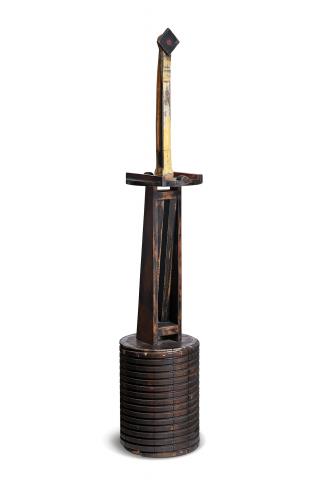No. 664, 1987
ROBERT KLIPPEL
wood assemblage
248.0 cm height
signed with initials, dated and numbered on side: RK. 664. 87.
Watters Gallery, Sydney
The Collection of Colin and Elizabeth Laverty, Sydney, acquired from the above in December 1990
Robert Klippel Sculptures, Christine Abrahams Gallery, Melbourne, 11 July – 28 July 1988
Robert Klippel Painted Wood Sculptures at Three Locations, Roslyn Oxley9 Gallery, Sydney, 6 November – late December 1990; Legge Gallery, Sydney, 13 November – 1 December 1990; Watters Gallery, Sydney, 14 November – 1 December 1990, cat. 46 (illus. in exhibition catalogue)
Robert Klippel Project Exhibition, Art Gallery of New South Wales, Sydney, 22 June – 13 August 1995
The Laverty Collection, Museum of Contemporary Art, Sydney, 20 June – 23 August 1998
Robert Klippel, Art Gallery of New South Wales, Sydney, 9 August – 13 October 2002
Loxley, A., ‘The Laverty Collection’, Art and Australia, Sydney, vol. 34, no. 1, 1996, p. 72 (illus.)
Edwards, D., Robert Klippel, Art Gallery of New South Wales, Sydney, 2002, p. 203 (illus.)
A bronze version of this work is included in a group of Robert Klippel sculptures on display, Brisbane Law Courts.
Laverty Collection_0010ADJ.jpg

The following excerpt is quoted from Edwards, D., Robert Klippel, Art Gallery of New South Wales, Sydney, 2002, pp. 187 – 188
‘Klippel’s beginning was his end. His large series of wooden pattern-part sculptures reiterates processes and principles that were in place in 1948. The last 15 years of his life saw a return to wood – a material he had not used since the 1940s – in yet another extraordinary outpouring of activity which resulted in a series of over 150 assemblages. The dramatic change was clearly that Klippel created these assemblages at a ‘monumental’ size previously unseen in his work. The decision to enlarge his works seems to have come from a desire to produce monumental sculpture before he felt unable to do so. Working with his extensive formal language and a huge range of parts, Klippel retained in these large sculptures the same mastery and inventiveness which he had brought to his junk and bronze sculptures, and the same will to articulate significant form through the dynamic relationships of mass, weight, volume and space. In a group as non-predictive as all of Klippel’s works, the artist returned to investigations of volume and mass, and created new manifestations of these consistent preoccupations. For 40 years, Klippel had dually wrestled with and relinquished the problem ‘of how to put the mass back into this inner structure.’1 In these monumental assemblages, Klippel massed and ‘re-surfaced’ his art, whilst he retained its transparent structure. If his 1960s junk assemblages find form for ceaseless energy, his monumental works – substantial, expansive, solid – hold weightier enclosed rhythms and sonorous reverberations of energy and matter in ways that imply a Platonic testament to permanent form within the larger flux.2 One could also argue that with them Klippel finally resolved his persistent preoccupation with sculpture and landscape through the most imaginative of means – by collapsing these categories into one form.’
1. Molloy, M., Salvat, K. and Australia Council, Robert Klippel, Keisal Films for Australia Council, Melbourne, 1975
2. Forms made more permanent by the casting of many of these works into bronze, through the Meridian Foundry in Melbourne
